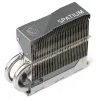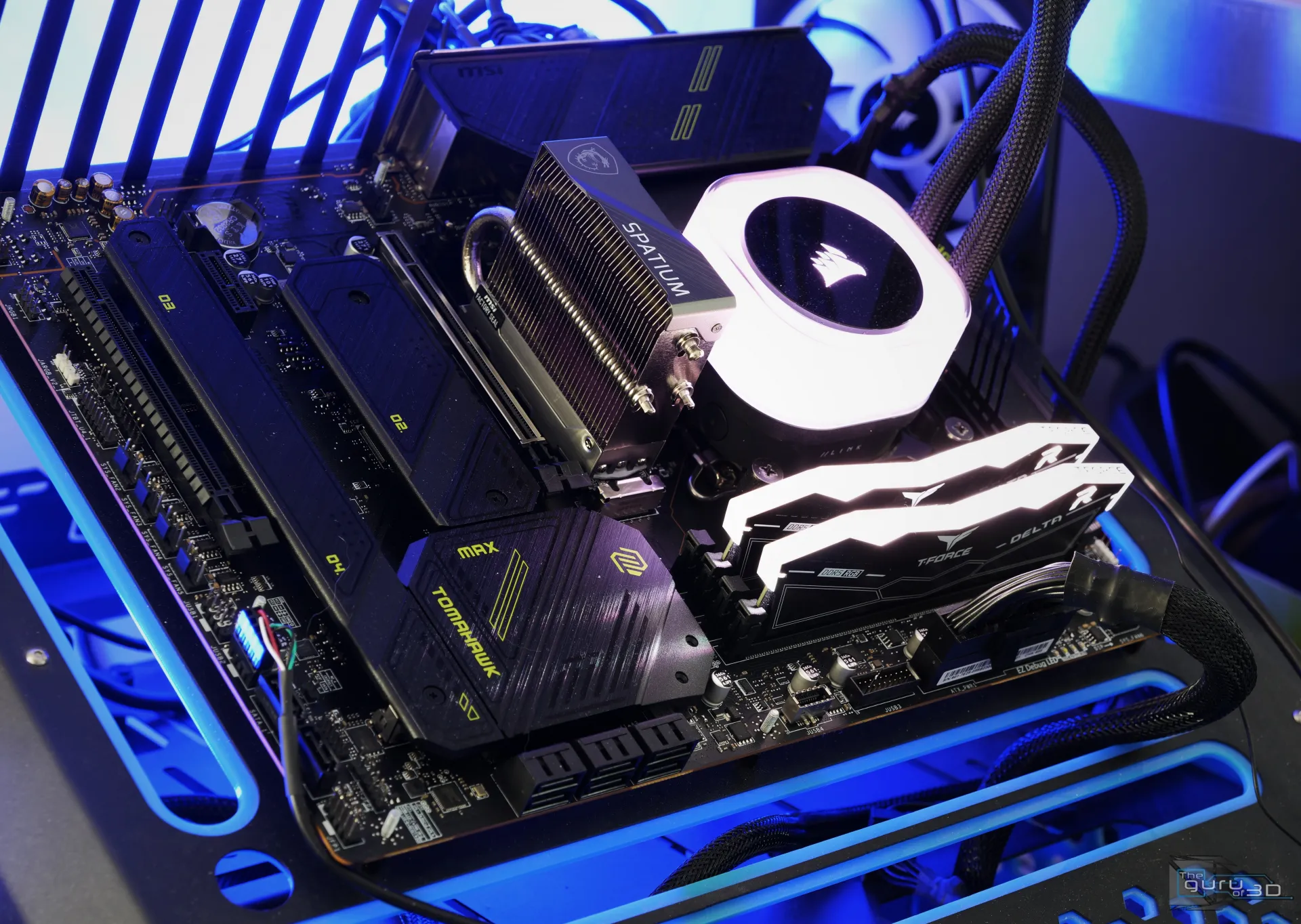Final Words & Conclusion
Yeah, this is the fastest Gen5 SSD we tested top date. In our recent reviews of new PCIe Gen 5 Solid State Drives (SSDs), thermal management emerged as a significant challenge, particularly with models equipped with Phison controllers. These SSDs exhibit difficulties in adequately dissipating heat from the controller and NAND memory modules. As a consequence, manufacturers have resorted to various heatsink designs, both active and passive, to address these cooling issues. During tests conducted without additional cooling measures, we observed that these SSDs, when uncooled, reached critical temperatures of around 90 degrees Celsius under intense workloads. This temperature threshold triggered a thermal shutdown, necessitating a power cycle to resume normal operation. Although data integrity was not compromised during these shutdowns, reaching such high temperatures in a matter of seconds under heavy loads is concerning. In contrast, the MSI Spatium M570 PRO FROZR PCIe 5.0 NVMe SSD demonstrated mich better thermal management thanks to the massive cooler, a bit of airflow inside your chassis however will be mandatory. . Equipped with effective cooling solutions, this SSD maintained operational temperatures, avoiding thermal shutdowns and ensuring consistent performance. It displayed notable performance, especially in tasks requiring sustained data transfer. However, our trace testing indicated that its performance benchmarks were comparable to high-end PCIe Gen 4.0 SSDs, suggesting that while thermal management is improved, the performance gains in certain applications may not be as substantial as expected in the transition from Gen 4.0 to Gen 5.0 SSDs.
In the realm of storage units, whether we truly need 10GB/s or faster speeds has sparked debates among enthusiasts. Some argue that these premium performance products are often synthetically measured, requiring significant workloads to utilize their capabilities fully. While it's true that your average users may not experience significantly faster boot times, slightly quicker game loadings, or noticeably faster application start-ups compared to NVMe SSDs with read/write speeds in the 2 GB/sec range, there is more to consider. Let's delve into the that. While the average user may not perceive a substantial difference, individuals who invest in top-tier components like a GeForce RTX 4090 or Radeon RX 7900 XTX, coupled with a powerful processor like the Core i9 14900K or Ryzen 9 7950X3D series, often seek that extra edge of performance, even if it may seem somewhat unrealistic. Technological advancements, such as DirectStorage, will slowly be aiding this landscape. With DirectStorage, graphics cards can directly access textures from the SSD, bypassing the processor and freeing up valuable processor cycles for other tasks. This technology significantly accelerates texture load times, providing a tangible benefit to those equipped with fast M.2 disks. Consider a scenario where you're launching a game with vast, intricate maps. With a fast M.2 disk and DirectStorage in action, you'll find yourself immersed in the game within seconds, an almost negligible loading time when compared to the long waits we've grown accustomed to. So, while the need for 10GB/s or faster storage units may not be immediately apparent, for those seeking every bit of performance, the potential gains in specific scenarios cannot be overlooked. Whether these gains are entirely realistic or not remains a topic for discussion.
Endurance
MSI offers 700 TBW (Terabytes Written) for the 1TB model, and 1400TBW for the 2TB model. We talked so much about this in the past already, endurance, the number of times NAND cells can be written before they burst and shatter into small pieces (well, they die and are mapped out, any data present on that cell is written to a healthy one). Bigger volume sizes mean more NAND cells; more NAND cells thus increase endurance. For the 2TB model, you'll get a rated 1400 TBW; the 1 TB model marks 700 TB written. So how long does a 1400 TWB storage unit last before NAND flash cells go the way of the dodo? Well, if you are an extreme user, you might be writing 50 GB per day (normal users likely won't even write that per week), but based on that value, 50GB x 365 days = 18.25 TB per year written. So that's almost 77 years of usage, double that for the 4TB SSD. And again, writing 50 GB per day is a very enthusiastic value.
Thermals
We know the E26 can get very hot, resulting in thermal throttling or a shutdown. It is MANDATORY to cool it under a heatsink, which is provided by this SKU. Being passively cooled, please make sure you have a bit of airflow inside your chassis.
Performance
The performance outcomes of the MSI Spatium M570 PRO FROZR PCIe 5.0 NVMe SSD are quite remarkable, particularly in terms of sequential transfers. the claim of "up to 12 GB/s" is indeed accurate, as we observed peak rates slightly above that threshold. However, this occurs at higher queue depths and thus sequential and linear queued workloads. For typical consumer workloads at lower depths, you'll easily see anywhere from 7 GB/s read and 9 GB/s write speeds, which are still mightily impressive. Random IO results and trace tests, however show this series to be virtually on par with those of PCIe Gen 4 drives, such as the Phison E18-NVMe SSDs. The MSI Spatium M570 PRO FROZR PCIe 5.0 NVMe SSD has a big (dynamic) SLC cache allowing it to accommodate substantial incoming write bursts easily. We measured this close to 700 GB SLC cache; the maximum feasible size for a 2 TB TLC drive is achieved. pSLC writes can be very fast exceeding 9-10 GB/s, but when exhausted, transfer rates plummet, which is your typical TLC write hole.
Concluding
The MSI Spatium M570 PRO FROZR PCIe 5.0 NVMe SSD has brought attention to the necessity for substantial cooling solutions in the SSD industry. Without an adequate heatsink, this SSD risks overheating and self-disabling within 30 seconds under heavy workloads. To resume functionality, a complete power cycle, which includes shutting down the computer, is required. The inclusion of a heatsink significantly enhances longer-term writes based on SSD's peak sustained and linear performance. Whether the added cost is justified by the benefits of peak performance we doubt. The pricing of the Spatium M570 PRO FROZR series is a notable factor, with the 2TB model priced at $299, or 15 cents per GB. This price point is higher compared to fast 2TB PCIe Gen 4.0 SSDs available at around $175, creating a significant disparity in the cost-performance ratio. Additionally, achieving optimal performance with the Spatium M570 PRO FROZR requires a PCIe 5.0 compatible motherboard and processor, limiting its use to the newest PCs. As the SSD market evolves, with prices generally decreasing, the premiums for PCIe 5.0 SSDs are expected to reduce, especially as more products become available. Upcoming drives with the Phison E26 controller are anticipated to offer enhanced performance. The Spatium M570 PRO FROZR, while featuring optional features and DirectStorage optimization, appears targeted towards early adopters. The performance gains over more cost-effective PCIe 4.0 drives are not substantial enough to justify the higher price for many users. Those who do not specifically need peak sustained read and write speeds, such as gamers or users with infrequent data transfers, should evaluate the necessity of the additional investment. In summary, the Spatium M570 PRO FROZR stands out for PC gamers and enthusiasts seeking top-tier sustained performance, offering impressive speeds in this regard. However, potential consumers really should balance the benefits with the price premium and assess their actual need for the enhanced performance this SSD provides. Beyond sustained read/write performance, the device's characteristics align closely with the premium PCIe Gen 4 SSD offerings. A robust cooling solution as offered with the Spatium M570 PRO FROZR is essential for optimal operation, underscoring the importance of adequate thermal management for high-performance SSDs. When you purchase it, give that heatsink a bit of airflow inside your chassis, please. If so, you're good to go.
Recommended Downloads
- Sign up to receive a notification when we publish a new article
- Or go back to Guru3D's front page.



